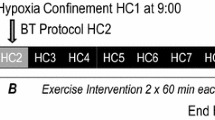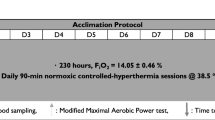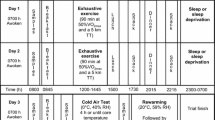Abstract
The potentiated exercise-sweating rate observed during acute hypoxia is diminished after a sleep-high train-low (SH-TL) regimen. We tested the hypothesis that this attenuation of the sweating response after SH-TL is compensated for by an increase in heat loss via vasodilatation. Nine male subjects participated in a 28-day SH-TL regimen. Before (pre-), and after (post-) the SH-TL protocol, they performed an \( \dot{V}{\text{O}}_{{ 2 {\text{peak}}}} \) test under normoxia and hypoxia. Additionally, pre- and post-SH-TL they completed three 30-min constant-work rate trials on a cycle ergometer. In one trial, the subjects inspired room air while exercising at 50 % of normoxic \( \dot{V}{\text{O}}_{{ 2 {\text{peak}}}} \) (CT). In the remaining trials, subjects exercised in hypoxia (FIO2 12.5 %), either at the same absolute (HAT) or relative (50 % of hypoxic \( \dot{V}{\text{O}}_{{ 2 {\text{peak}}}} \)) work rate (HRT) as in CT. Despite similar exercise core temperature responses between pre- and post-SH-TL trials, sweating rate was potentiated in HAT pre-SH-TL [CT: 1.97 (0.42); HRT: 1.86 (0.31); HAT: 2.55 (0.53) mg cm−2 min−1; p < 0.05]. Post-SH-TL exercise sweating rate was increased for CT, and remained unchanged in HRT and HAT [CT: 2.42 (0.76); HRT: 2.01 (0.33); HAT: 2.59 (0.30) mg cm−2 min−1]. Pre-SH-TL, the forearm-fingertip skin temperature difference (Tskf−f) was higher in HAT than in CT and HRT by ~3.5°C (p < 0.05). The inter-condition differences in Tskf−f were diminished post-SH-TL. In conclusion, the decrease in sweating rate during hypoxic exercise, following a SH-TL regimen, was countered by an increase in vasodilatation (reduced Tskf−f), whereas SH-TL enhanced the sweating response during normoxic exercise. The mechanisms underlying these SH-TL-induced alterations in thermoregulatory responses remain to be settled.



Similar content being viewed by others
References
Ainslie PN, Hamlin M, Hellemans J, Rasmussen P, Ogoh S (2008) Cerebral hypoperfusion during hypoxic exercise following two different hypoxic exposures: independence from changes in dynamic autoregulation and reactivity. Am J Physiol Regul Integr Comp Physiol 295:R1613–R1622
Amano T, Ichinose M, Koga S, Inoue Y, Nishiyasu T, Kondo N (2011) Sweating responses and the muscle metaboreflex under mildly hyperthermic conditions in sprinters and distance runners. J Appl Physiol 111:524–529
Ashenden MJ, Gore CJ, Dobson GP, Hahn AG (1999) “Live high, train low” does not change the total haemoglobin mass of male endurance athletes sleeping at a simulated altitude of 3,000 m for 23 nights. Eur J Appl Physiol Occup Physiol 80:479–484
Bocqueraz O, Koulmann N, Guigas B, Jimenez C, Melin B (2004) Fluid-regulatory hormone responses during cycling exercise in acute hypobaric hypoxia. Med Sci Sports Exerc 36:1730–1736
Buono MJ, Sjoholm NT (1988) Effect of physical training on peripheral sweat production. J Appl Physiol 65:811–814
Duncan A, Meek JH, Clemence M, Elwell CE, Tyszczuk L, Cope M, Delpy DT (1995) Optical pathlength measurements on adult head, calf and forearm and the head of the newborn infant using phase resolved optical spectroscopy. Phys Med Biol 40:295–304
Eiken O, Mekjavic IB (2004) Ischaemia in working muscles potentiates the exercise-induced sweating response in man. Acta Physiol Scand 181:305–311
Gonzalez-Alonso J, Eiken O, Mekjavic IB (2008) A critical core temperature and the significance of absolute and relative work rate. In: Groeller Herbert, Taylor NAS (eds) Physiological bases of human performance during work and exercise. Elsevier, Sydney, pp 481–485
Gore CJ, Hopkins WG (2005) Counterpoint: positive effects of intermittent hypoxia (live high:train low) on exercise performance are not mediated primarily by augmented red cell volume. J Appl Physiol 99:2055–2057 Discussion 2057–2058
Greenleaf JE, Greenleaf J, Card DH, Saltin B (1969) Exercise-temperature regulation in man during acute exposure to simulated altitude. J Appl Physiol 26:290–296
Havenith G, van Middendorp H (1990) The relative influence of physical fitness, acclimatization state, anthropometric measures and gender on individual reactions to heat stress. Eur J Appl Physiol Occup Physiol 61(5–6):419–427
House JR, Tipton MJ (2002) Using skin temperature gradients or skin heat flux measurements to determine thresholds of vasoconstriction and vasodilatation. Eur J Appl Physiol 88:141–145
Kacin A, Golja P, Eiken O, Tipton MJ, Gorjanc J, Mekjavic IB (2005) Human temperature regulation during cycling with moderate leg ischaemia. Eur J Appl Physiol 95:213–220
Kacin A, Golja P, Eiken O, Tipton MJ, Mekjavic IB (2007) The influence of acute and 23 days of intermittent hypoxic exposures on the exercise-induced forehead sweating response. Eur J Appl Physiol 99:557–566
Kondo N, Takano S, Aoki K, Shibasaki M, Tominaga H, Inoue Y (1998) Regional differences in the effect of exercise intensity on thermoregulatory sweating and cutaneous vasodilation. Acta Physiol Scand 164:71–78
Kondo N, Tominaga H, Shibasaki M, Aoki K, Koga S, Nishiyasu T (1999) Modulation of the thermoregulatory sweating response to mild hyperthermia during activation of the muscle metaboreflex in humans. J Physiol 515(Pt 2):591–598
Langton JA, Hanning CD (1990) Effect of motion artefact on pulse oximeters: evaluation of four instruments and finger probes. Br J Anaesth 65:564–570
Machado-Moreira CA, Smith FM, van den Heuvel AM, Mekjavic IB, Taylor NA (2008) Sweat secretion from the torso during passively-induced and exercise-related hyperthermia. Eur J Appl Physiol 104:265–270
Mekjavic IB, Eiken O (2006) Contribution of thermal and nonthermal factors to the regulation of body temperature in humans. J Appl Physiol 100:2065–2072
Nadel ER, Pandolf KB, Roberts MF, Stolwijk JA (1974) Mechanisms of thermal acclimation to exercise and heat. J Appl Physiol 37:515–520
Owen-Reece H, Elwell CE, Wyatt JS, Delpy DT (1996) The effect of scalp ischaemia on measurement of cerebral blood volume by near-infrared spectroscopy. Physiol Meas 17:279–286
Roberts MF, Wenger CB, Stolwijk JA, Nadel ER (1977) Skin blood flow and sweating changes following exercise training and heat acclimation. J Appl Physiol 43:133–137
Rubinstein EH, Sessler DI (1990) Skin-surface temperature gradients correlate with fingertip blood flow in humans. Anesthesiology 73:541–545
Saito M, Mano T, Iwase S, Koga K, Abe H, Yamazaki Y (1988) Responses in muscle sympathetic activity to acute hypoxia in humans. J Appl Physiol 65:1548–1552
Shibasaki M, Kondo N, Crandall CG (2001) Evidence for metaboreceptor stimulation of sweating in normothermic and heat-stressed humans. J Physiol 534:605–611
Shibasaki M, Secher NH, Selmer C, Kondo N, Crandall CG (2003) Central command is capable of modulating sweating from non-glabrous human skin. J Physiol 553:999–1004
Stickland MK, Morgan BJ, Dempsey JA (2008) Carotid chemoreceptor modulation of sympathetic vasoconstrictor outflow during exercise in healthy humans. J Physiol 586:1743–1754
Subudhi AW, Dimmen AC, Roach RC (2007) Effects of acute hypoxia on cerebral and muscle oxygenation during incremental exercise. J Appl Physiol 103:177–183
Subudhi AW, Lorenz MC, Fulco CS, Roach RC (2008) Cerebrovascular responses to incremental exercise during hypobaric hypoxia: effect of oxygenation on maximal performance. Am J Physiol Heart Circ Physiol 294:H164–H171
Tankersley CG, Smolander J, Kenney WL, Fortney SM (1991) Sweating and skin blood flow during exercise: effects of age and maximal oxygen uptake. J Appl Physiol 71:236–242
Townsend NE, Gore CJ, Hahn AG, Aughey RJ, Clark SA, Kinsman TA, McKenna MJ, Hawley JA, Chow CM (2005) Hypoxic ventilatory response is correlated with increased submaximal exercise ventilation after live high, train low. Eur J Appl Physiol 94:207–215
Van Beekvelt MC, Colier WN, Wevers RA, Van Engelen BG (2001) Performance of near-infrared spectroscopy in measuring local O2 consumption and blood flow in skeletal muscle. J Appl Physiol 90:511–519
van der Zee P, Cope M, Arridge SR, Essenpreis M, Potter LA, Edwards AD, Wyatt JS, McCormick DC, Roth SC, Reynolds EO et al (1992) Experimentally measured optical path lengths for the adult head, calf and forearm and the head of the newborn infant as a function of inter optode spacing. Adv Exp Med Biol 316:143–153
Wang JS, Wu MH, Mao TY, Fu TC, Hsu CC (2010) Effects of normoxic and hypoxic exercise regimens on cardiac, muscular and cerebral hemodynamics suppressed by severe hypoxia in humans. J Appl Physiol 109:219–229
Xie A, Skatrud JB, Puleo DS, Morgan BJ (2001) Exposure to hypoxia produces long-lasting sympathetic activation in humans. J Appl Physiol 91:1555–1562
Yamazaki F, Fujii N, Sone R, Ikegami H (1994) Mechanisms of potentiation in sweating induced by long-term physical training. Eur J Appl Physiol Occup Physiol 69:228–232
Yanagimoto S, Aoki K, Horikawa N, Shibasaki M, Inoue Y, Nishiyasu T, Kondo N (2002) Sweating response in physically trained men to sustained handgrip exercise in mildly hyperthermic condition. Acta Physiol Scand 174:31–39
Acknowledgments
We would like to thank all the subjects for their cooperation and patience. We are grateful to Bogomir Vrhovec and Mojca Amon for their valuable assistance. This study was supported by a grant from the Slovenian Research Agency (ARRS grant no. L7-2413) to Igor B. Mekjavic, and from b-Cat B.V. (The Netherlands) to Igor B. Mekjavic and Ola Eiken.
Conflict of interest
The authors state that there is no personal conflict of interest in the present study.
Author information
Authors and Affiliations
Corresponding author
Additional information
Communicated by George Havenith.
Rights and permissions
About this article
Cite this article
Kounalakis, S.N., Eiken, O. & Mekjavic, I.B. Exercise thermoregulatory responses following a 28-day sleep-high train-low regimen. Eur J Appl Physiol 112, 3881–3891 (2012). https://doi.org/10.1007/s00421-012-2374-0
Received:
Accepted:
Published:
Issue Date:
DOI: https://doi.org/10.1007/s00421-012-2374-0




